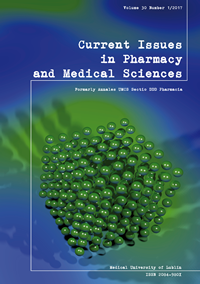Using micronized progesterone for treatment of premenopausal age women suffering from severe premenstrual syndrome
DOI:
https://doi.org/10.1515/cipms-2017-0025Keywords:
PMS, treatment, per menopause, micronized progesteroneAbstract
In this study, we carried out the clinical and laboratory research of severe PMS (premenstrual syndrome) treatment in premenopausal age women. Herein, 37 women were examined and observed before the beginning of treatment and three months after it. Medication containing micronized progesterone was used for treatment (sublingually, 100 mg from 11 to 25 days of menstrual cycle). After three months of micronized progesterone treatment, 86.5% of all women-participants of the study were observed to have full regression of clinical symptoms, while 13.5% of all patients were observed to have decrease in clinical symptoms of severe PMS. Moreover, hormonal research results revealed significant (1.3 times) decrease in LH (Luteinizing hormone) level and (1.3 times) increase in progesterone level after three months of treatment (р<0.05). The high bio-accessibility of the medication and its natural structure made it possible to decrease the dose and avoid risks of hepatotoxicity.
References
1. Hryhorenko, A.P., Horbatiuk, O.H., Shatkovska, A.S.: Menstrual cycle and its regulation. Meditsinskiye aspekty zdorovya zhenshchin, 17, 4, 2012.
2. Hryhorenko, A.P., et al. Correction of premenstrual syndrome in perimenopausal women. Meditsinskiye aspekty zdorovya zhenshchin, 51, 3, 2017.
3. Kochetov, A.G. et al., (2012). Methods of statistical medical data processing: methodical guideline for postgraduate students. Moscow: RKNPK; p. 42.
4. Manuhin, I.B. Tumilovich, L.G. Gevorkian, M.A. (2014). Gynecological endocrinology. Clinical lecture: guideline. Moscow: Geotar-Media; p. 267.
5. Nappi, R.E., et al. Luteal phase dysphoric disorder and premenstrual syndrome. Ital. J. Psych. Behav. Scien., 27, 28, 2009.
6. Opryshko, V.I. Nosivets D.S.: The originality of the forms of micronized progesterone. Z turbotoyu pro zhinku, 12, 8, 2016.
7. Saidova, R.A., Aleksanian, S.G., Tropynina, E,V.: Contemporary principles of the hormonal correction of menstrual disorders in perimenopausal period. Voprosy gynekologiyi, akusherstva i perinatologiyi, 46, 4, 2008.
8. Studd, J. Spotlight on severe premenstrual syndrome and bipolar disorder: a frequent tragic confusion. Climacteric, 602, 14, 2011.
9. Tatarchuk, T.F. et al., (2000). Principles and methods of correction of the hormonal disorders in peri - and post-menopause: methodical guideline. Kiev; p. 25.
10. Vichlayeva, Y.M., editor (2006). Guideline for endocrinological gynecology. Moscow: MIA; p. 784.
Downloads
Published
Issue
Section
License
Copyright (c) 2017 Authors

This work is licensed under a Creative Commons Attribution-NonCommercial-NoDerivatives 3.0 Unported License.


